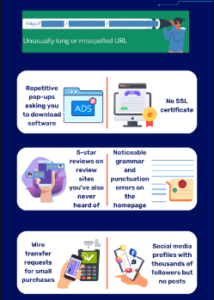What Is SEO Poisoning:
What is the most common goal of search engine optimization poisoning? Threat actors use the SEO (search engine optimisation) poisoning approach to raise the position of their malicious websites in search engine results. Threat actors deceive visitors into accessing what appear to be trustworthy websites by using a variety of negative SEO strategies to affect search engine results. Users who unwittingly connect with dangerous websites run the risk of disclosing critical information to threat actors or letting malware infect their devices.
What Is Malware:

An application or file that is intended to harm or exploit a computer, network, or server is known as malware, short for malicious software.
Malware has been around almost as long as computers. It has significantly changed in both shape and functionality throughout time. The original computer viruses were crude experiments, oddball pieces of software that didn’t do much more than show a few text popups.
Malware today is a whole other animal. It is employed for anything from extortion to data exfiltration, service interruption, and plain destruction as the weapon of choice for the majority of threat actors. In today’s threat landscape, malware may be found in almost every nook and cranny, whether it be as harmful code fragments, self-replicating programs, or criminally motivated software-as-a-service platforms.
The key to the threat that malware poses to enterprises is its diversity, which is also one of its greatest strengths.
What is the most common goal of search engine optimization poisoning:
An important part of Internet marketing is search engine optimisation (SEO), which works to increase a website’s exposure in search engine results. It entails a variety of tactics and methods to raise a website’s position, ultimately generating organic traffic and boosting its online visibility.
Understanding SEO:
What is the most common goal of search engine optimization(SEO) poisoning? SEO includes a variety of on-page and off-page techniques that aid in the comprehension, assessment, and ranking of web pages by search engines. This entails optimising a variety of factors, including backlinks, website structure, content quality, and keywords.
One of the main goals of SEO is to make a website’s content and structure compatible with search engine algorithms, increasing the likelihood that it will show up in pertinent search results. However, not all SEO techniques are ethical, and some people or organisations take part in actions that are intended to trick search engines. This is often referred to as SEO poisoning.
The Goal of SEO Poisoning:
What is the most common goal of search engine optimization(SEO) poisoning: SEO poisoning’s main objective is to deceitfully or maliciously alter search engine results. Contrary to ethical SEO techniques, which seek to benefit people, SEO poisoning has a hidden agenda. Attackers frequently direct unwary people to dangerous information by using a number of unethical tactics to increase the exposure of their website in search results.
Common Techniques Used in SEO Poisoning:
- Keyword Stuffing: In order to influence search engine rankings, keyword stuffing includes using a lot of keywords—oftentimes unrelated ones. Attackers may bury these keywords in a webpage’s code or overuse them in the visible content.
- Cloaking: Cloaking is a dishonest practice in which the material displayed to people differs from that displayed to search engine crawlers. This is done by presenting the user with modified material after identifying the user’s IP address or other criteria.
- Link Farming: Link farming is a technique used to artificially increase a website’s backlink profile. A network of websites interlink with one another, frequently utilising automated technologies. Rankings may temporarily improve as a result, but search engines penalise such behaviour.
- Doorway Pages: Doorway pages are low-quality webpages designed primarily to rank for particular keywords and link viewers to more, sometimes irrelevant material. They act as access points to various areas of a website.
- Malware Distribution: SEO poisoning may occasionally be used to spread malware. Attackers may route consumers to websites that try to infect their devices through false approaches.
The Dangers of SEO Poisoning:
Both consumers and website owners are in serious danger from SEO poisoning. Users could be sent to websites that try to transmit malware, steal personal information, or carry out other criminal acts. It damages consumers’ confidence in search results, maybe making them more wary of clicking on links.
Being a victim of SEO poisoning can have serious repercussions for website owners. Google and other search engines aggressively seek for and penalise websites using deceptive tactics. This may lead to a decline in ranks, a reduction in organic traffic, or even manual penalties that may be difficult to overcome.
Protecting Against SEO Poisoning:

Regular Audits: To find and correct any shady or manipulative practices on your website, do routine SEO audits.
Stay Informed: To make sure that your techniques adhere to moral principles, keep up with the most recent SEO best practices and search engine recommendations.
Use Reputable SEO Tools: Use reputable SEO tools and software to track and enhance the performance of your website.
Implement Security Measures: To protect yourself from malware and other internet hazards, use strong security measures.
what is the most common goal of search engine optimization(SEO) poisoning – video for you
How to Avoid Getting SEO Poisoned:
What is the most common goal of search engine optimization (SEO) poisoning: To preserve a secure online experience, both website owners and visitors must avoid SEO poisoning. You may take the following actions to protect yourself against SEO poisoning:
Keep Software and Plugins Updated:
Make sure that the CMS (Content Management System) on your website, as well as any plugins or extensions, are up to current. Attackers may target outdated software.
Use Strong Passwords:
For all of your accounts, create complicated, one-of-a-kind passwords that you update frequently. Useless passwords like “password123” or “admin” should be avoided.
Implement HTTPS:
To encrypt data sent between your website and visitors’ browsers, utilise HTTPS. This provides defence against man-in-the-middle and eavesdropping attacks.
Regularly Monitor Website Analytics:
Watch the statistics on your website for any suspicious or odd traffic increases. It’s possible that this is a sign of SEO poisoning.
Perform Regular Security Audits:
Make rigorous assessments of the security controls on your website, searching for any gaps that may be exploited.
Stay Informed about SEO Best Practices:
Keep up with the most recent SEO best practices and search engine recommendations to make sure you’re not unintentionally using manipulative techniques.
Avoid Suspicious Links:
When clicking on links, use caution, especially if they come from unreliable sources or look fraudulent. Before clicking, hover over links to view their destination URL.
Use Reputable SEO Tools:
Make sure the SEO tools you employ come from reliable sources if you utilise them. Don’t download or use tools from shady or dubious websites.
Monitor Backlinks:
Check the backlink profile of your website frequently to make sure there aren’t any shady or subpar connections pointing at it.
Educate Your Team:
If you have a staff monitoring your website, ensure sure they are informed about appropriate practices and are aware of the dangers of SEO poisoning.
Employ Website Security Solutions:
Use security plugins or services to assist in shielding your website from numerous threats, such as SEO poisoning.
Regularly Backup Your Website:
Keep current backups of the databases and information on your website. In the event of an assault, you will have a clean version to restore thanks to this.
Set Up Google Search Console Alerts:
If there is any unusual activity on your website, such as a rapid rise in 404 errors or security problems, Google Search Console may give you notifications.
Be Cautious with User-Generated Content:
Implement procedures to monitor and filter submissions for potentially hazardous or malicious information if your website permits user-generated content.
By taking these precautions, you may dramatically lower your chance of contracting SEO poisoning and contribute to the upkeep of a safe online environment for both you and the visitors to your website.
Conclusion For what is the most common goal of search engine optimization poisoning
Online marketing relies heavily on SEO, but it’s important to distinguish between ethical SEO tactics and SEO poisoning. To be safe and preserve the integrity of the online ecosystem, website owners and visitors must both understand the goals and tactics underlying SEO poisoning. We can all work together to make the internet experience more dependable and trustworthy by sticking to ethical SEO practices. To protect yourself from malware and other internet hazards, use strong security measures.
